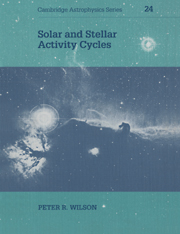Book contents
- Frontmatter
- Contents
- Preface
- Acknowledgments
- 1 Introduction
- 2 Historical survey
- 3 The structure of the Sun and the phenomena of activity
- 4 The equations of magnetohydrodynamics and magnetohydrostatics
- 5 The one-dimensional configuration of the cycle
- 6 Heuristic models of the solar activity cycle
- 7 Stellar activity and activity cycles
- 8 The two-dimensional representation of the extended activity cycle
- 9 The origin of the large-scale fields
- 10 The reversal of the polar magnetic fields
- 11 The role of dynamo theory in cyclic activity
- 12 Helioseismology and the solar cycle
- 13 Cyclic activity and chaos
- 14 Forecasting the solar cycle
- 15 Summary and conclusions
- Author index
- Subject index
12 - Helioseismology and the solar cycle
Published online by Cambridge University Press: 27 October 2009
- Frontmatter
- Contents
- Preface
- Acknowledgments
- 1 Introduction
- 2 Historical survey
- 3 The structure of the Sun and the phenomena of activity
- 4 The equations of magnetohydrodynamics and magnetohydrostatics
- 5 The one-dimensional configuration of the cycle
- 6 Heuristic models of the solar activity cycle
- 7 Stellar activity and activity cycles
- 8 The two-dimensional representation of the extended activity cycle
- 9 The origin of the large-scale fields
- 10 The reversal of the polar magnetic fields
- 11 The role of dynamo theory in cyclic activity
- 12 Helioseismology and the solar cycle
- 13 Cyclic activity and chaos
- 14 Forecasting the solar cycle
- 15 Summary and conclusions
- Author index
- Subject index
Summary
Introduction
The measurement and interpretation of the travel times of earthquake signals have been used for many years to study the structure of the Earth's interior. In addition to the classical method, observations of free oscillations have been used since the great Chilean earthquake of 1960, and this branch of seismology has been recently applied to the Sun with considerable success. For a given solar model, the eigenfunctions and eigenfrequencies of the radial velocity perturbations may be calculated by standard methods and compared to the observed frequencies. Improved models of the internal structure of the Sun may be obtained by bringing as many calculated frequencies as possible into agreement with observed frequencies. Such calculations have, for example, forced the rejection of ‘low-Z’ models of the solar interior which, it had been hoped, might resolve the solar neutrino problem (Christensen-Dalsgaard and Gough 1982).
Of particular interest for studies of cyclic phenomena is the rotational modulation of the eigenmode frequencies. Because the eigenfunctions of the many non-radial p-modes exhibit different depth and latitude dependence, the measurement of frequency splittings in the intermediate orders of the waves has led to inferences regarding the internal rotation rate as a function of depth and latitude (Duvall et al. 1986, Brown and Morrow 1987, Morrow 1988, Brown et al 1989, Libbrecht 1989). Surprisingly, these results at first suggested that, within certain error bars, the angular velocity is independent of radial distance across the convection zone; i.e. that the differential rotation (with latitude) at the base of the convection zone is very similar to that at the surface.
- Type
- Chapter
- Information
- Solar and Stellar Activity Cycles , pp. 208 - 227Publisher: Cambridge University PressPrint publication year: 1994



